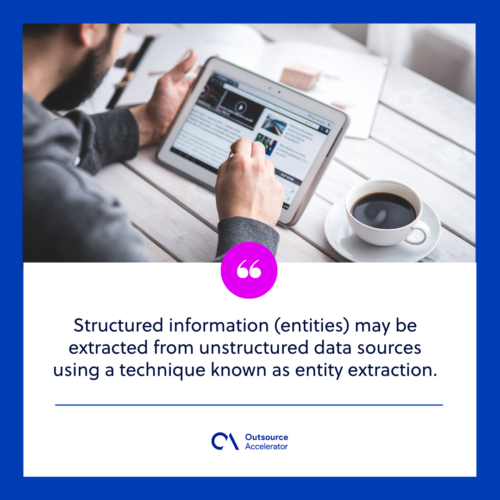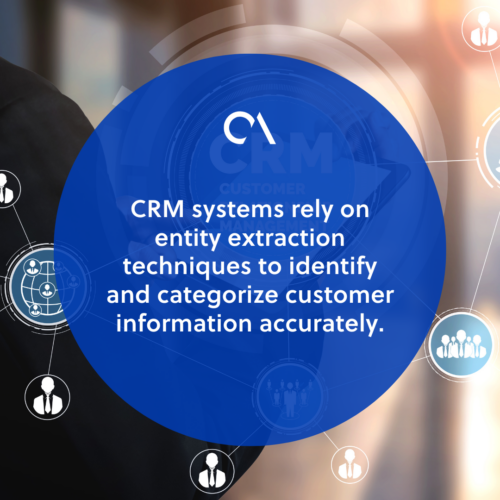Essential insights on entity extraction: A must-know guide

Now that we live in the 21st century, information’s sheer volume and complexity make it difficult for a human entity to derive actionable insights from raw data instantly.
Good thing there is an emerging new technique for data extraction—entity extraction. This method helps organizations interpret unstructured data and make data-driven choices via computer systems.
What is entity extraction?
Structured information (entities) may be extracted from unstructured data sources using a technique known as entity extraction.
Some common unstructured data sources are:
- Text documents
- Social media posting
- Customer reviews
- Online articles
These entities can include various components, including people’s names, organizations, places, dates, and monetary values.
Businesses may convert raw data into structured, actionable information using entity extraction strategies.

Types of business entities
Here are some of the common types of business entities:
People
Individuals, and their related properties, such as names, occupations, and positions, are people entities.
People entity extraction and analysis have applications in various domains, including:
- Human resources
- Customer relationship management
- Social network analysis
Businesses may improve their personnel management, increase consumer relations, and obtain insights about social connections by analyzing people entities.
Private limited company
A private limited companies are corporate entities whose members’ liability is restricted to their shareholdings.
A small number of people often hold these businesses and can be found in the following industries:
- Technology
- Manufacturing
- Service providers
This entity type is popular among entrepreneurs looking for a structured business arrangement that balances ownership control.
Limited company
This may sound similar to the private limited company, but unlike the latter, this is a separate legal entity from its owners
It means that members’ obligations are restricted to their investments or shareholdings. Limited corporations are common in many industries and can be public or private.
Statutory corporation
A statutory company is a legally created government-owned entity. The government has granted these corporations certain rights like legal management and governance in certain areas of public interest.
Nonprofit organization
The main goal of nonprofit organizations is to serve social or philanthropic causes rather than make money. These organizations are committed to community improvement, environmental preservation, healthcare, and education.
Nonprofit organizations offer beneficial services, fight for certain causes, and try to solve societal problems. This business entity is supported through fundraisers, gifts, and grants.
Applications and use cases of entity extraction
Entity extraction covers certain applications across numerous industries and domains.
Let’s explore some of the prominent use cases of entity extraction:
Customer relationship management (CRM)
CRM systems rely on entity extraction techniques to identify and categorize customer information accurately.
Extracting entities such as names, contact details, preferences, and purchase history enables businesses to:
- Enhance customer engagement
- Personalize marketing campaigns
- Deliver exceptional customer experiences

Financial analysis
In the finance industry, entity extraction assists in gathering and analyzing information from financial reports and market data.
Financial analysts can make informed investment decisions by extracting entities in the financial sector, detecting anomalies, and generating valuable insights.
Social media monitoring
With the expansion of social media platforms, businesses increasingly leverage entity extraction for better social media management.
Social media managers may identify influencers and track brand mentions using entity extraction techniques.
Meanwhile, extracting entities such as hashtags, user mentions, locations, and sentiment helps companies understand customer perceptions.
3 entity extraction techniques
Here are the three entity extraction techniques you should know:
1. Rule-based
Rule-based techniques rely on predefined patterns or rules to identify and extract entities. Two common rule-based methods are regular expressions and dictionary matching, which are further explained below:
Regular expressions
Regular expressions are powerful search patterns that identify and extract entities that follow specific patterns or formats.
Suppose we have a document with a list of email addresses. Our objective is to find all of the email addresses in the text. We can accomplish this with regular expressions.
For instance:
In this message, “If you have any questions, please contact us at [email protected] or [email protected] or [email protected] for urgent problems.”
Data analysts may use this regular expression code to extract the email addresses:
\b[A-Za-z0-9._%+-]+@[A-Za-z0-9.-]+\.[A-Za-z]{2,}\b
Here’s the breakdown of regular expression code:
| \b | Matches a word boundary, ensuring the email address is extracted. |
| [A-Za-z0-9._%+-]+ | Matches one or more alphanumeric characters, dots, underscores, percentage signs, plus signs, or hyphens, which are allowed in the local part of an email address. |
| @ | This separates the local part from the domain of an email address. |
| [A-Za-z0-9.-]+ | This represents one or more alphanumeric characters, dots, or hyphens in the domain part of an email address. |
| \. | This code separates the domain name from the top-level domain (TLD). |
| [A-Za-z]{2,} | This matches two or more alphabetic characters for the TLD. |
| \b | This matches another word boundary, ensuring the complete email address was coded. |
Dictionary matching
Dictionary matching is a strong entity extraction approach that identifies and extracts entities based on predetermined lists or dictionaries.
Suppose we have a text document with a section regarding countries and their capitals. The first step is to identify the countries mentioned in this text:
“Canada is known for its spectacular scenery—ranging from the towering Rocky Mountains to the majestic Niagara Falls.
The United States, a melting pot of cultures and a beacon of liberty, captivates with renowned sights like the Statue of Liberty and the Grand Canyon, representing natural wonders and the pursuit of the American dream. Meanwhile, Japan entices travelers with its rich history and beautiful combination of tradition and modernity.”
Next, develop a dictionary or list of nation names, such as:
- Canada
- United States
- Japan
This method is very effective when working with scattered categories, such as the names of nations, cities, companies, or other domain-specific entities. This makes it easier to sort all types under one section.
2. Statistical and machine learning
Statistical and machine learning techniques automatically employ advanced algorithms to learn patterns and features.
Here are three popular techniques within this category:
Named Entity Recognition (NER)
NER is a machine-learning approach that recognizes and categorizes named items in the text, such as human names, organizations, and places. It builds models that can detect and extract things in unseen text using annotated training data.
Hidden Markov Models (HMM)
HMM is a statistical model frequently used for sequence labeling tasks such as entity extraction.
It predicts the probability distribution of sequences of the entity and non-entity words—allowing for reliable entity extraction in context.
Conditional Random Fields (CRF)
CRF is a graphical probability model used for sequential labeling tasks. It evaluates the dependencies between neighboring words and employs contextual information to improve the accuracy of entity extraction.
3. Hybrid
Hybrid techniques combine rule-based, statistical & machine learning entity extraction techniques to achieve optimal results.
By leveraging the strengths of both methods, hybrid techniques can handle complex entity extraction tasks more effectively.







 Independent
Independent




